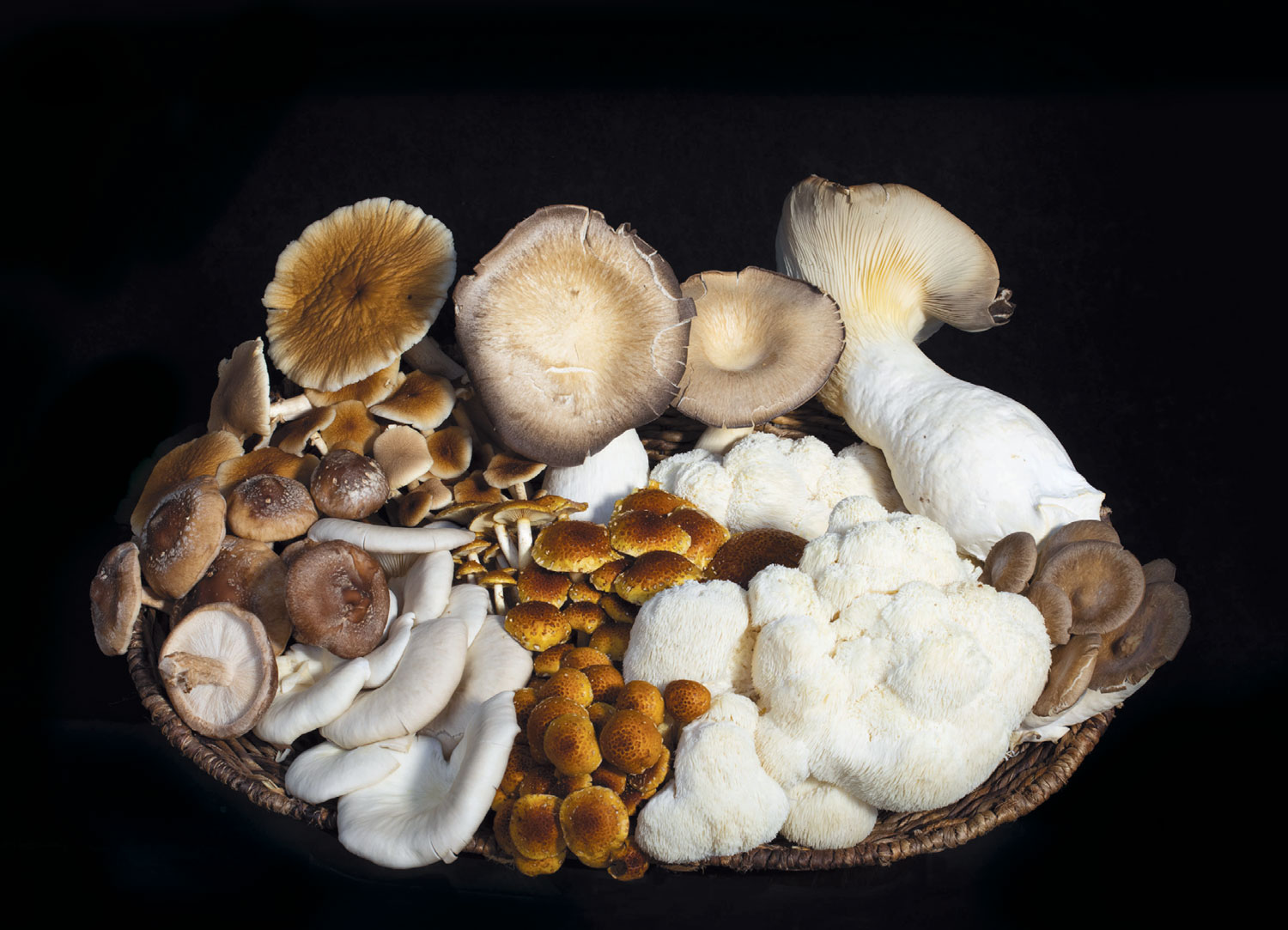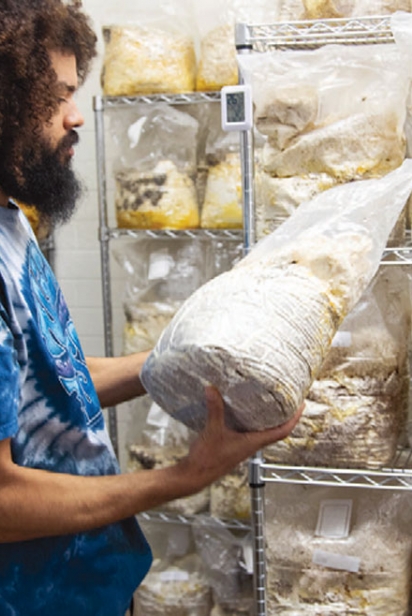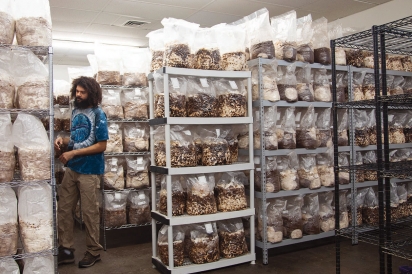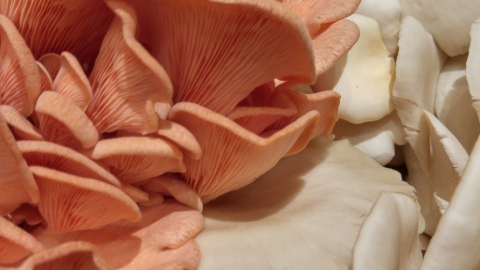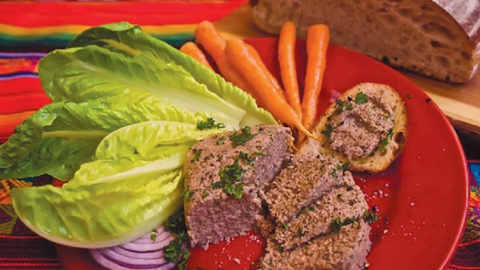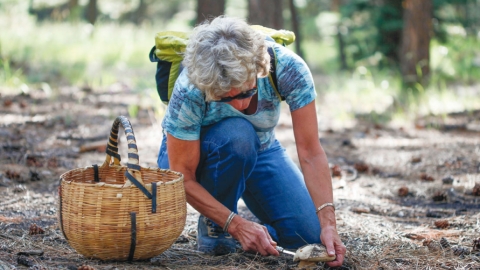Not Your Grandparent's Button Mushrooms
Gourmet Mushrooms in Arizona Are Coming Your Way…
My fascination with unusual mushrooms started about 10 years ago at the lively farmers market in cool, wet Beaverton, Oregon. I was drawn to the cultivated mushrooms in a fantasy of colors, sizes and shapes.
Look at this: lion’s mane, a shaggy white beard. Or this: hen-of-the-woods (aka maitake), a cute little ruffled bunch. The enoki came in delicate long-stemmed bunches; the royal trumpets (also known as “chicken legs”) were thick and stout. Grey or golden dove mushrooms floated elegantly reflecting a pearlescent sheen. The lobster mushrooms stood out, bright orange-red and lumpy.
I really wanted to taste them all but couldn’t, as I was just traveling through and didn’t have any way to cook them.
For years there was only one type of mushroom in Arizona’s markets: boring white buttons, Agaricus bisporus. Several years ago crimini and portobello mushrooms also became available. But they are both also Agaricus bisporus (just a brown variation); the portobellos being nothing more than a mature version of the first. Even more recently an occasional flush of shiitake or enoki would show up, usually imported and looking shriveled and sad. Nothing like those vital healthy mushrooms in Oregon.
But this is changing.
Mushrooms are the fruiting body of fungi—a huge and intriguing subject. They are neither plant nor animal, belonging to a separate life kingdom. They are the powerful but hidden deconstructors and reconstructors of life. They turn garbage into compost, downed trees into forest mulch and dead animals into components that can support new life.
Fungi (singular: fungus) have very different requirements from plants. They don’t produce their own food. They don’t have bodies. And they grow from a network of fine filaments called mycelia (singular: mycelium) that extract nutrients from decaying life around them.
Fungi mycelia connect and support forests. Yeast is a fungus used to ferment beer and wine and raise bread. Fungi are a source of antibiotics, natural pesticides and medical cures. Fungi can help reverse bee colony collapse, break down oil spills and plastic waste and restore farmlands. Certain fungi can help build disease resistance. If you want to know more, catch the powerful movie Fantastic Fungi (fantasticfungi.com).
Although mushrooms sprout from a mature mycelium network, not all fungi produce mushrooms. Still, there are a lot of mushrooms—about 10,000 types have been identified but many, many more have not. Most mushrooms are tasteless or inedible. Some will make you a little sick. A few are deadly and a few are psychedelic. Of the edible and delicious varieties very few are cultivated, maybe 20, but this number is growing, especially in Arizona.
For the past several years Barry Pryor, PhD, University of Arizona faculty member and director of the Arizona Mushroom Growers Association (azmushroomgrowers.org), has been teaching small-scale mushroom production in our desert environment. The AZMGA has almost 400 members. Check it out. You might want to become one of them. Their mission is to make “mushroom cultivation accessible to growers in Arizona and to encourage the success of mushroom growers across the state.”
Mushroom cultivation in the desert is complicated. You have to replicate growing conditions like those in Oregon. I visited three local mushroom grow sites. Two were in suburban homes with converted bedrooms and garages creatively repurposed with cobbled equipment: humidifiers, fans and temperature control units. It’s real urban farming. The third was a professional “urban grow farm” with computer-controlled, stainless steel state-of-the-art equipment and climate controls.
Anywhere you do it, mushroom growing requires rigorous procedures, meticulous care and tightly controlled environments. Labs and incubation rooms must be as sterile as an operating room. Grow material “substrates” (sawdust, wheat straw, manure, even coffee grounds) are sterilized under pressure and heat to destroy competing organisms. Then the substrate is packed into blocks and inoculated with “spawn” (mycelia) in front of a HEPA laminar flow cabinet so no microscopic fungi spores float in to contaminate the batch. These blocks, or “bales,” are held in an incubation room for 10–60 days while the mycelia thread their way through the entire mass. Finally, the bales are slashed to let air in and moved into a grow room where they sprout mushrooms.
After the sterile, carefully controlled lab and incubation rooms, the grow rooms seem dreamlike—a misty world bursting with enchanted, contorted, colorful mushrooms. I was eager to get some of these beauties home and do a tasting. What are they like? Meaty, lobster-ish, delicate, earthy, nutty? You can taste for yourself because they are now available in Arizona—in farmers markets and in select grocery stores, also online. See the sources below. Then check out the Mushroom Tasting recipe and select your favorite replacement( s) for those boring old button mushrooms.
Impact of COVID-19
Mushroom Mike of Southwest Mushrooms reports that he had just ramped up production for a contract with Shamrock Foods. With the closure of many restaurants he has had to cut back but is still growing a lot. Mike is partnering with local chefs to design mushroom-based products like Basil Shiitake Ice Cream. Watch for this and other mushroom-forward flavor blasts at the Downtown Phoenix Public Market.
Though missing the restaurant trade, Kevin Fitzgerald of Sun Valley Harvest reports that he is picking up a lot of business at farmers markets and through direct sales. He’s getting lots of support from customers, enough to employ family members who have been laid off of other jobs. As an educational service he offers mushroom grow kits to homeschooled kids and teachers at no charge.


